
 |
||||||||
|
|
||||||||
|
|||||||||||||||||||||||||||||||||||||||
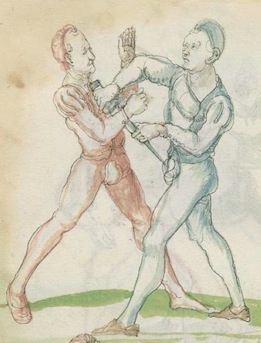 |
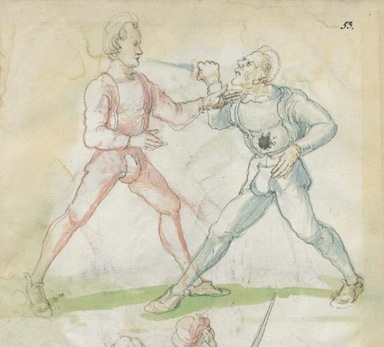 |
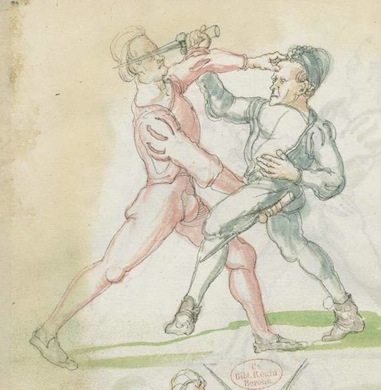 |
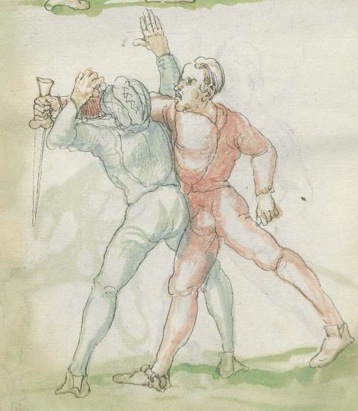 |
| Techniques wonderfully illustrated from an anonymous early 16th century German Fechtbuch. The physical form and the flow of the actions are nothing short of astonishing in the wealth of martial wisdom they convey to the knowing eye. Posture, footwork, motion, contact...This is not a matter of any "style" but application of leverage, timing, balance, and closing distance to intercept or counter the attacker. | |||
|
A common arm-lock technique from Fiore dei Liberi's work of c.1409 above, and the same technique form Fillipo Vadi's treatise of c.1482. The illustrations denote subtle differences in stance, motion, pressure, energy, intent, and contact points that can effect substantial differences of result. Yet, rather than different "styles" both depict the same essential action with the same fundamental concepts at work. |
In contrast, by examining the whole body of related contemporary European martial literature, you begin to see a pattern: that the major source works present keystone techniques as examples from which the student is able to reasonably and soundly extrapolate other connected actions. I am firmly convinced that is exactly why their authors consciously chose the specific ones to include that they did, because they are seminal. They wisely knew which were the essential techniques that once understood would inherently teach still others. I'm convinced they were compiled for that very reason. Years of discovery and analysis matched with years of instructing in just what I uncovered taught me this insight. Having to write down or draw out what I knew or what lesson I wanted to convey in print, let alone in video lessons and live seminars, also confirmed for me that there are certain things which just unlock everything else.
If a particular source shows, for example, a mere four or five plates on polaxe, does that then mean there are only that many possible actions that this author knew or approved of with that weapon? Does that mean to study those teachings the student today must be limited to exactly those few actions and no other whatsoever? Should not the logical extension of the same source's content on longsword or spear simply be extended to that weapon, thereby providing a far larger repertoire of polaxe techniques? It's common sense that the concepts a master provides for fighting with each weapon he covers are to a large extent interchangeable. It is a simple matter of saving space and avoiding repetition for them to not have presented the general teachings for every case. I believe they knew their readers were wise enough to understand this. Many works even contain no text at all but only reference artwork featuring a small portion of what are in-arguably very fundamental actions (stances, strikes, displacements, closures, weapon seizures, leg-hooks, etc.). These collections are surely meant as samples of centerpiece moves from which to learn the larger method. They provide a starting point by reminding the student of the basics. They are hardly meant to be the entire craft itself.
Still, the bottom line is that no one can claim content that is not present in a source. The evidence has to be there. Instead, we must admit when conjecture and speculation is the result of reasoned extrapolation. And no student of the subject can dismiss that process out of some adherence to "canonical purity." Again, if you focus on core principles and larger concepts and do not pursue a "technique-based" approach to the craft, you will understand far more, for insight and analysis of the source teachings does not occur in a vacuum. The challenge now as students of this craft is not from where to start but where to draw the line.
We might for instance do an exhibition for the public and be asked if the late-14th century master Fiore dei Liberi would have done a certain kind of reasonable technique. We could offer an informed opinion based on the totality of the four editions attributed to his teachings combined with what we know about armed combat at the time to elaborate on the simple sophistication of his method. We process the matter through what we know of the movement form and motions derived directly from exercise in performing his larger teachings. Or we may end up just saying simply, "We don't know." But it be would not be right to flatly declare, "No, absolutely not because it's not in his work!"
I'm reminded here of my favorite line in the 14th century teachings of Johannes Liechtenauer; the one that reads how the simple truth of his words will be self-evident to anyone who can otherwise fight. This passage doesn't mean you have to know his secrets beforehand in order to understand his writings. It means, rather, that the simple truth of his method will be grasped by anyone else who also knows how to properly fight because his teachings just make good martial sense because they're founded on the common laws that underscore all close-combat. As the master Joachim Meyer wrote in his famous treatise of 1570 when discussing practice:
"...you shall also know that although I have assigned to every posture its particular devices, it is not my intention that these shall not be executed or take place from other postures. The chiefest reason that I have assigned some actions to one posture, others to another, is so they can be discussed in an orderly fashion. Also, these actions are not so set in stone that they cannot be changed in practice; they are merely examples from which everyone may seek, derive, and learn devices according to his opportunity, and may arrange and change them as suits him. For as we are not all of a single nature, so we cannot all have a single style in combat; yet all must nonetheless arise and be derived from a single basis."
In other words, the manner by which Meyer presented his material was such that he did not mean any particular technique was only to be used in whichever fighting stance he described it as being performed in, but by whatever one it works from. The Art is flexible and principles apply holistically. Meyer even stated that, "everyone thinks differently from everyone else, so he behaves differently in combat." Are we to really believe that only Master Meyer was wise enough to know these things that are general knowledge even among many modern amateurs? I hardly think so.
|
The authors of the myriad treatises and books on Renaissance martial arts were not stupid. They knew what they were doing when they presented self-defense material and they knew their audiences knew things as well. If a historical source shows a simple grapple of one arm by one hand when using a dagger, then any moderately talented practitioner can figure out the same action works on the opposite side with a different weapon entirely, even if such an action is not specifically included in that source. If they depict in one single example a closure to grab a weapon and hook a leg around a knee it's obvious this is something that applies across the board in fighting. Similarly, if a source work depicts a half-sword deflection to the center, then the same move works on the left and the right (In fact, things "working on both sides" is itself a concept in many sources). If they teach a strike underneath, then it likely works above and vice-verso. If they show a particular blow with the pommel it's a surety it also works with the point or the cross. Would a historical fighting man really need every conceivable permutation and possibility spelled out to understand this? Do we? We might find ourselves saying, "Well, yes that particular move isn't shown but it's very likely, and we think probable, that such a simple thing as this was known and performed by the author, since it's so obvious and fits consistently with everything else they show, besides appearing in other sources from the age." This is reasonable, even as it assumes a fact not in evidence --providing nothing contradicts the underlying foundational principles the source presents. |
|
If
a somewhat obvious and even simple action appears in one source but not
another of the same region or era, or at least is not depicted in the
same identical form in different works, does that mean we cannot explore
it as a contemporary technique?
|
Added to this is the unarguable fact that the better written
works offer
not just techniques or moves but general elements and higher
concepts
that form the basis for their fighting methods. (The symbolism
alone which
they contain speaks volumes not directly related in their
technical examples.)
A perfect example is how many later works in the German school
expound
on things only vaguely referenced at in earlier sources consisting of
less sophisticated
images and less technical descriptions. The only counter
argument is to suggest that an author chose in this instance not to
include certain moves because he considered them risky or less
effective, a view that has precedent.
|
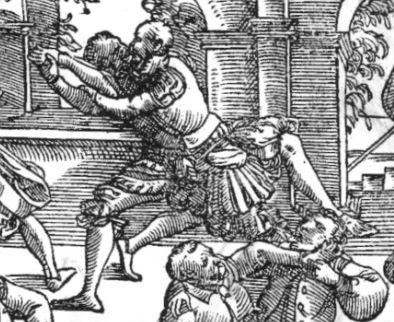 |
I think it foolish to imagine any one resource contained and represented the entire repertoire of moves and skills these experts knew at the time. Nothing whatsoever suggests any particular example action in the sources is somehow meant to be employed (or practiced) as some unaltered sole means of defense in the violent life-threatening chaos of personal combat. The fact that no source I am aware of asserts something like, "this content is the only thing you will ever do or ever need and there is nothing else" is a dead giveaway on this, although both masters Filippo Vadi and P.H. Mair say, for example, that they included in their material only what they witnessed and were personally confident worked. This itself is a confirmation that there was more they knew existed. In the words of the master Viggiani from his 1551 Lo Schermo, "if I wanted to show you today the entire art and the entirety of the mastery of arms... not only would I not know how to do so easily, but moreover I could not do it in the space of a year." I won't even address the historical possibility of botta secreta ("secret techniques"), but I will defer to Master Joachim Meyer's consequential statement on how his readers should endeavor to "advance the Art on their own."
So, it's a perfectly legitimate approach to say, for the sake of authenticity, "We will ONLY demonstrate the X plate technique from Talhoffer." But from that you cannot then say in the negative, "Talhoffer would never have performed nor approved of Y technique or Z action since he did not specifically show it," because you don't really know that. You can't prove the negative. Rather than assuming facts not in evidence it assumes lack of evidence as factual absence. Instead, I submit support for experimentation and inclusionary study within modern practice of Renaissance martial arts comes from how reasonably actions relate to other contemporary sources. Now, this certainly doesn't mean you can go from a Zornhau (diagonal forward-edge downward cut) to arguing for spinning back-kicks. There have to be boundaries and parameters, and these are found, I argue, by holistically examining the totality of the material, contrasting and comparing it based on understanding the nature of the activity itself.
In a great many ways there are parallels between how people typically approach religious scripture and how they now approach historical fencing literature. There are all sorts of ways to read meanings into the material. There are ways of translating nuances, interpreting intention of the authors, taking pieces out of context, reaching conclusions out of the wording. Disagreements over core tenets are inevitable to one degree or another as students make it meet their own needs, processing the lessons into applications for practical exercise and drill. Different people will naturally see incompatible things in the teachings based on their own subjective experience and education. Pretty soon one view of the material becomes irreconcilable with another. Short of time-travel to learn the real teachings of Renaissance martial arts, I don't believe there is any way around this. We can debate the accuracy of translations, and the integrity of transcriptions, and we can analyze and challenge physical demonstrations of their application, but some things will really never be definitively resolved because the martial arts, like all personal and military conflict throughout history, will never be a true science.
Back in the late 1990s, when I was shifting the original old "HACA" club from a generalized fencing interest to an exclusive focus upon the source teachings of the historical masters, I ran into friction with our founder, Hank Reinhardt. Hank was resistant to the new emphasis on reconstruction through scholarship and interpretation. Frankly, it intimidated him. He knew next to nothing about it, and what we were already beginning to show directly eviscerated most of his theories and conjectures on how to fence with different swords and weapons. Most of all, I saw discovery of the material undermine his confidence as an authority on historical close-combat. Hank said to me that he "wasn't going to be slave to some old book!" Thus began his preaching about how "we really don't know" if these works represented anything other than hype and self-promotion like today's modern authors of knife-fighting courses and assorted self-defense systems. This notion of the source teachings somehow being uncertain has since been dismissed as the foolishness it was. But the essential point, that we "can't truly know," has a certain validity.
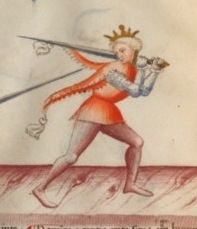 |
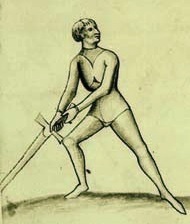 |
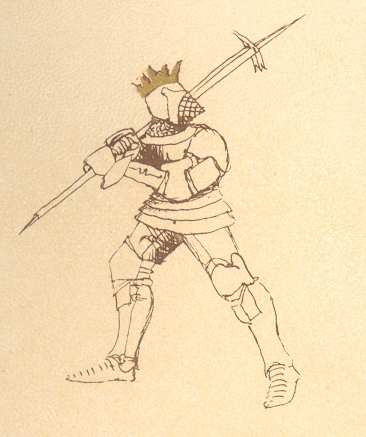 |
| Because the very same fighting postures and combat actions can appear in military artwork from outside of Renaissance martial arts literature they provide yet another avenue by which to understand and affirm the methods presented in the source teachings. | ||
|
|
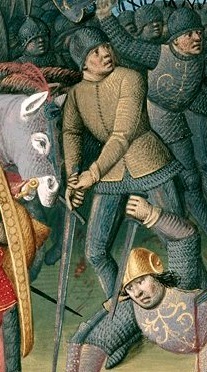 |
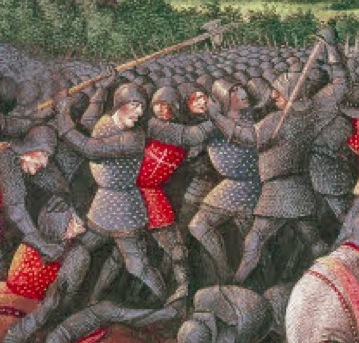 |
| Below: just one example of the same essential technique as seen in two entirely different sources, one Italian, circa 1409, the other German, circa 1520. |
||
|
Illustrations in the voluminous works of Renaissance martial arts literature are often not of specific fighting techniques so much as representative examples of very general concepts and common self-defense actions which all follow from the same underlying principles.
|
There is a simple question to consider in the effort to study and interpret the source teachings of Renaissance martial arts: Can we or can we not accurately reconstruct them? If we can not... then whatever anyone does is going to be dubious and always corrupted by modern influences. If we can, however, then the question is raised of what means we determine accuracy? What standards of authenticity and historicity are to be valued?
Everyone who professes to be a serious student of this subject relies upon the same general sources. There are simply no other surviving sources of historical authority. Differences among practitioners then are only in matters of execution of actions, which themselves result from differences of practice, that in turn derive from differences of goals, motives, and especially aptitude, and that most significant of differences: accurate training equipment. This makes for quite a wide diversity of efforts going on, without even accounting for the different values at work among various organizations and loose affiliations. Ultimately, all efforts to restore these teachings to a modern practice comes down to approximation. Since no one today knows for sure how these arts were actually taught or learned and no one is using them for real life combat, all training comes down to different degrees of approximating the reality of what they once were.
The only way to really judge whatever is being done to match the historical descriptions and images then is to evaluate its physicality. That is, in the performance of techniques and execution of fighting actions we can consider the motion, the speed, the force, the energy, and the coordination by which they're accomplished. In other words, how skillfully. Some practitioners will move better than others. Why is that? Because they are better. How is that? Because they train better. Because they were taught better. And perhaps because by nature they are just more adept at it. But even then we must consider that whatever is done is still a modern interpretation, not the original.
A decade or so ago in the ARMA we were devising drills and exercises as a means of rediscovering the source teachings. We were exploring the Art by trying to learn its techniques and terminology. This stage was a necessary though backward approach. Nowadays, by contrast, we essentially know the Art and our drills and exercises come directly out of understanding its core principles. Performing techniques correctly and knowing the meaning of terminology flow from this.
As a result of studying the historical sources and attempting to practice their teachings what then have we come to know? We have learned how to do the actions and techniques they describe. We have learned to apply the principles and concepts they explain. We practice this in the manner their examples provide. We perform it not as mere posed postures or slow motion imitation, but with the prerequisite energy and speed, the intensity, intrinsic to such violence. We wield weapons, manipulate limbs, and work bodies in the very same way they describe or illustrate. In interpreting the whole of their lessons we have recovered the motions involved. And in doing this, comparing ourselves to the historical images, we discern how we indeed look the same. We thereby come to understand how they needed to move. Appreciating this functionality, we believe we know what form their style must have taken. Having become adept at it, we then find we understand the meaning of their words with insight and clarity. This is how we can now reliably present a confident reconstruction of the martial arts of Renaissance Europe.
| So, where does that leave us in the struggle between canon and Art? I
leave that to the reader to deduce for themselves, but the words of master
Meyer come to mind when he rightfully observes: "the Art depends upon
the person, so that a poor move will be executed by an ingenious mindful
person much more usefully in the action, than the best one will be executed
by a fool." I have seen this truth born out a thousand times. There is a valid point to be made that you shouldn't be doing a technique if it isn't in the source material you're endeavoring to understand. Unless, that is, the action is easily extrapolated organically from the teachings themselves. Doing this is hardly sacrilege. Just when and where to draw the line on it is the real matter. Our objective, after all, is understanding through reviving study and exercise, but because we are relying on text and images, not living authorities who represent the original craft, no reconstruction of extinct practices can ever be free of subjective interpretation. In the end, the fact that a historical fighting move is martially sound is the surest indicator that the interpretation of the teaching is indeed accurate, for ultimately interpretation means application. One should not miss the Art in the effort to worship canon. |
|
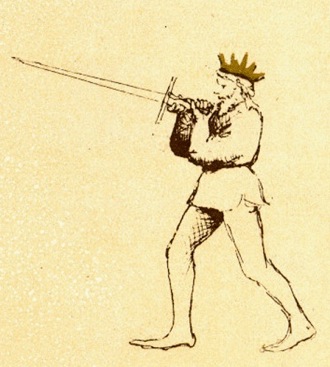 |
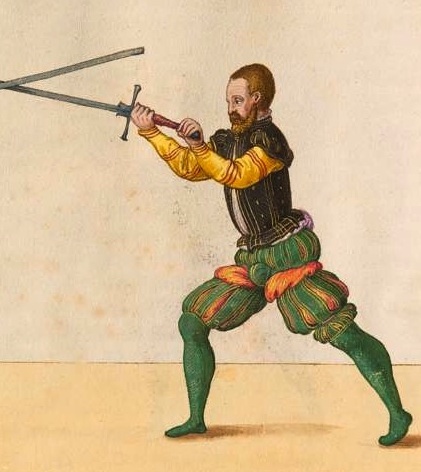 |
| Naturally, the same basic actions exist within the major sources of Italian and German combat teachings on weapons from the late-1300s through the early-1600s. Understanding one helps augment our grasp of the other. | |||
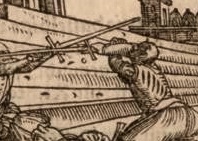 |
|||
See
Also:
Challenges
and Rewards
|
|
|||
|
|
|||
|
|||